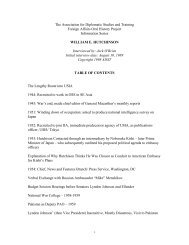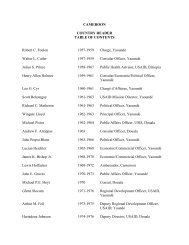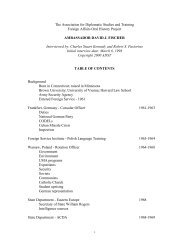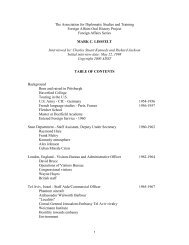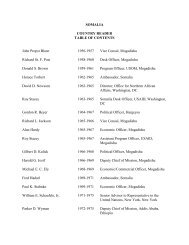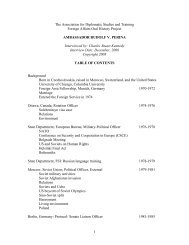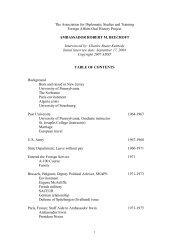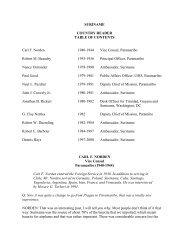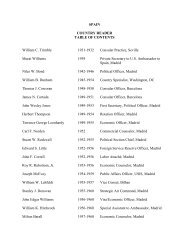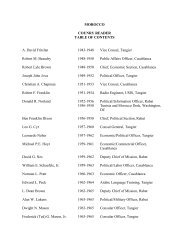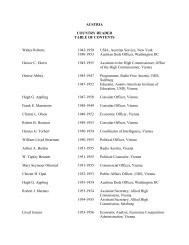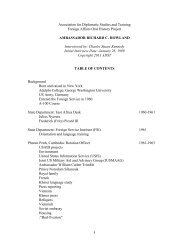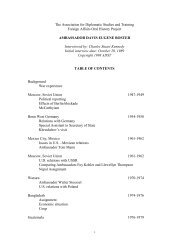1 The Association for Diplomatic Studies and Training Foreign ...
1 The Association for Diplomatic Studies and Training Foreign ...
1 The Association for Diplomatic Studies and Training Foreign ...
Create successful ePaper yourself
Turn your PDF publications into a flip-book with our unique Google optimized e-Paper software.
A very good case in point is how the regions reacted – that is, the republics. <strong>The</strong>re is an<br />
Estonian named Igor Grazin, who was one of the key members of the Estonian delegation<br />
to the Supreme Soviet, the last two. He was half-Estonian, half Russian, a personification<br />
of the Sovietization of the Baltic States. Grazin is an extraordinary international lawyer,<br />
he was first in his class in several universities <strong>and</strong> law school, including Moscow <strong>and</strong><br />
ended up here, in the United States as a professor at Notre Dame. He went back to<br />
Estonia as a legislator of an independent republic. His position was similar to that of<br />
many Ukrainians <strong>and</strong> certainly those of the Warsaw state members from Eastern Europe,<br />
that the Gorbachevian approach of regional autonomy was the right one. That was their<br />
view, <strong>and</strong> that was the view of the Bush administration. However, Gorbachev had to go<br />
further beyond rhetoric in order to make it work, <strong>and</strong> that was to give increasing<br />
autonomy to the new elements that were in the political equation. It wasn’t simply<br />
independence <strong>for</strong> nationalist tribes, but it was an inclusion of intellectuals, of artists, of all<br />
of these people who had been kept out, <strong>and</strong> they were now part of the equation, <strong>and</strong> they,<br />
in fact, were what were in the last two Supreme Soviets. That was the new Soviet Union.<br />
<strong>The</strong> reality was there.<br />
<strong>The</strong> leadership of the Soviet state structure – the bureaucracy, the apparatus – could not<br />
adjust to that new reality. <strong>The</strong>y resisted the internal changes that were necessary to<br />
con<strong>for</strong>m to the new realities. <strong>The</strong> outcome of the clash between the new reality <strong>and</strong> the<br />
old structure was that the new reality, being much larger <strong>and</strong> more able, won the day.<br />
<strong>The</strong> last several years of perestroika is an extraordinarily interesting period that, I think,<br />
needs to be understood by those who are interested in the new Russia. It is necessary to<br />
know the condition of the <strong>for</strong>mer Soviet Union at that crossover point, <strong>and</strong> the issues that<br />
were at play. It is important to know what the perestroika group represented <strong>and</strong> what<br />
independence of the nationalities or the republics meant, what the ideological changes<br />
were, how they might have been otherwise, had the Soviet state kept together. So 1991<br />
was an extraordinarily heady, yeasty, bubbling, kind of turbulent period. It was a real<br />
search <strong>for</strong> an optimum solution in which there were society-wide struggles over the<br />
fundamental law, many particular subsidiary laws, structures of government, including<br />
state <strong>and</strong> local governments, cultural institutions <strong>and</strong> city governments. <strong>The</strong> intensity of<br />
the society-wide participation in the creation of the new state was remarkable <strong>and</strong><br />
inspiring, to me as an American.<br />
Q: You were in Moscow still?<br />
MILLER: Yes, I was, a good deal of the time, up until 1993. In that period while I was<br />
living there, <strong>and</strong> I was very closely involved with the key players in the drama, from<br />
Gorbachev <strong>and</strong> Yeltsin to the leaders in the Supreme Soviet <strong>and</strong> Moscow city government<br />
<strong>and</strong> even the clergy.<br />
Q: It always struck me that one of the major problems with the Soviets – I mean, this is<br />
obvious – was the economic controls. Were things happening there?<br />
163




